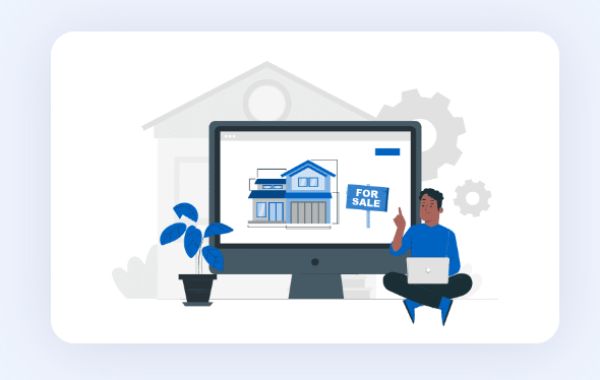Introduction:
In today's digital era, mobile apps have revolutionized various industries, and the real estate sector is no exception. Real estate apps offer a convenient platform for property listings, buying, selling, and renting properties. However, building a successful real estate app requires careful planning, development, and investment. In this in-depth article, we will explore the factors that influence the real estate app development cost, delve into the app development process, and provide essential insights for creating a feature-rich and user-friendly app that meets your business needs.
Real Estate App Development Cost: Factors that Influence the Cost
1. App Features and Complexity
The range of features you want to include in your real estate app significantly impacts the development cost. Basic apps with essential functionalities will be more affordable than complex apps with advanced features like 3D property tours, augmented reality (AR) integration, property search filters, mortgage calculators, and in-app messaging.
2. Design and User Experience (UX)
Creating an intuitive and visually appealing user interface enhances the user experience and increases the app's attractiveness to potential users. Investing in high-quality UI/UX design will add to the overall development cost.
3. Platform and Device Compatibility
Deciding whether to build a real estate app for a single platform (iOS or Android) or both, as well as ensuring compatibility with various devices, will affect the development cost.
4. Development Team and Location
The experience and expertise of the development team are crucial factors. Hiring a skilled team with a track record in real estate app development may cost more than outsourcing to a team in a different location with lower labor costs.
5. Backend Development and Data Storage
Building a robust backend infrastructure to handle user data, property listings, and other information is essential for a seamless app experience. The complexity of the backend will contribute to the overall cost.
6. App Testing and Quality Assurance
Thoroughly testing the app for bugs, glitches, and security vulnerabilities is vital. Investing in comprehensive quality assurance will ensure a smooth user experience but will also add to the cost.
7. App Maintenance and Updates
Post-launch, regular maintenance and updates are necessary to keep the app running smoothly and up-to-date with the latest technologies. Budgeting for ongoing maintenance is crucial for the long-term success of the app.
The Real Estate App Development Process: Step-by-Step Guide
1. Idea Validation and Market Research
Begin by validating your app idea and conducting extensive market research. Identify your target audience, competitors, and unique selling points to ensure your app meets the needs of potential users.
2. Wireframing and Prototyping
Create wireframes and prototypes to visualize the app's layout and functionalities. This step allows you to make early design decisions and identify any potential issues.
3. UI/UX Design
Invest in creating an appealing and user-friendly interface. Ensure that the design aligns with your brand identity and offers seamless navigation.
4. Frontend and Backend Development
Develop the frontend and backend of the app simultaneously. The frontend focuses on the user interface, while the backend handles data storage, retrieval, and app functionality.
5. Testing and Quality Assurance
Conduct rigorous testing at every development stage to identify and fix any bugs or glitches. Implement security measures to protect user data.
6. Launch and Deployment
Prepare for the app's launch by submitting it to the app stores and promoting it across various channels. Monitor user feedback and make necessary improvements.
7. Post-Launch Support and Updates
Provide ongoing support to users and regularly update the app with new features and improvements based on user feedback.
Essential Tips for Building a Successful Real Estate App
1. Focus on User Experience
Prioritize a seamless and enjoyable user experience. Ensure that users can easily browse listings, filter search results, and contact sellers or agents.
2. Integrate Advanced Search Filters
Include advanced search options like location, price range, property type, and amenities to help users find their desired properties quickly.
3. Offer High-Quality Images and Virtual Tours
High-resolution images and virtual property tours provide users with a better understanding of the properties they are interested in.
4. Implement In-App Messaging
Enable direct communication between users, sellers, and agents through in-app messaging to facilitate negotiations and inquiries.
5. Ensure Security and Privacy
Implement robust security measures to protect user data and build trust among your app's users.
6. Provide Mortgage Calculators and Financial Tools
Integrate mortgage calculators and financial tools to assist users in making informed decisions about property purchases.
FAQs (Frequently Asked Questions) on Real Estate App Development Cost
Q: How much does it cost to develop a real estate app?
The cost of developing a real estate app varies depending on several factors, such as the app's features, complexity, platform, and development team. On average, a basic app can cost between $20,000 to $50,000, while a more complex app with advanced features can range from $100,000 to $250,000 or more.
Q: How long does it take to develop a real estate app?
The development timeline for a real estate app also depends on its complexity and features. On average, it can take anywhere from 4 to 9 months to complete the development process.
Q: Should I build a native app for iOS and Android or opt for a cross-platform app?
The decision between a native or cross-platform app depends on your target audience, budget, and required features. Native apps provide better performance and user experience, but cross-platform apps can save development time and cost by using a single codebase.
Q: How can I monetize my real estate app?
You can monetize your real estate app through various strategies, such as in-app advertisements, premium listings for real estate agents, charging a fee for featured listings, or implementing a subscription model for exclusive access to advanced features.
Q: Is it essential to provide ongoing maintenance for the app?
Yes, regular maintenance is crucial to ensure your app's optimal performance, security, and compatibility with the latest operating systems and devices.
Q: Can I integrate third-party APIs into my real estate app?
Absolutely! Integrating third-party APIs, such as map services, payment gateways, and social media logins, can enhance your app's functionality and user experience.
Conclusion:
Building a successful real estate app requires careful planning, investment, and a keen focus on user experience. By understanding the factors that influence the development cost, following a well-structured development process, and implementing essential features, you can create a standout app that caters to the needs of property seekers and sellers alike. Embrace innovation, keep user feedback at the forefront, and continuously update your app to stay competitive in the dynamic real estate market.







